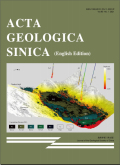地质学报(英文版)2024,Vol.98Issue(3):585-601,17.DOI:10.1111/1755-6724.15181
Apatite Fission-Track Thermochronology in the Tamusu Area,Bayingobi Basin,NW China,and its Geological Significance
Apatite Fission-Track Thermochronology in the Tamusu Area,Bayingobi Basin,NW China,and its Geological Significance
摘要
关键词
apatite fission-track/tectono-thermal history/sandstone-hosted uranium deposit/Bayingobi basin/Central Asian Orogenic BeltKey words
apatite fission-track/tectono-thermal history/sandstone-hosted uranium deposit/Bayingobi basin/Central Asian Orogenic Belt引用本文复制引用
TONG Qinlong,QIN Mingkuan,YE Fawang..Apatite Fission-Track Thermochronology in the Tamusu Area,Bayingobi Basin,NW China,and its Geological Significance[J].地质学报(英文版),2024,98(3):585-601,17.基金项目
We thank Dr.Zhang Jia from Beijing Research Institute of Uranium Geology,for help with the AFT results analysis.We also appreciate Liu Bo,Yang Yunhan,Ma Long,Jia Jin for their assistance with fieldwork.We are grateful to two anonymous reviewers for their thoughtful and constructive comments and suggestions.This study has been financially supported by the project of nuclear energy development. ()

